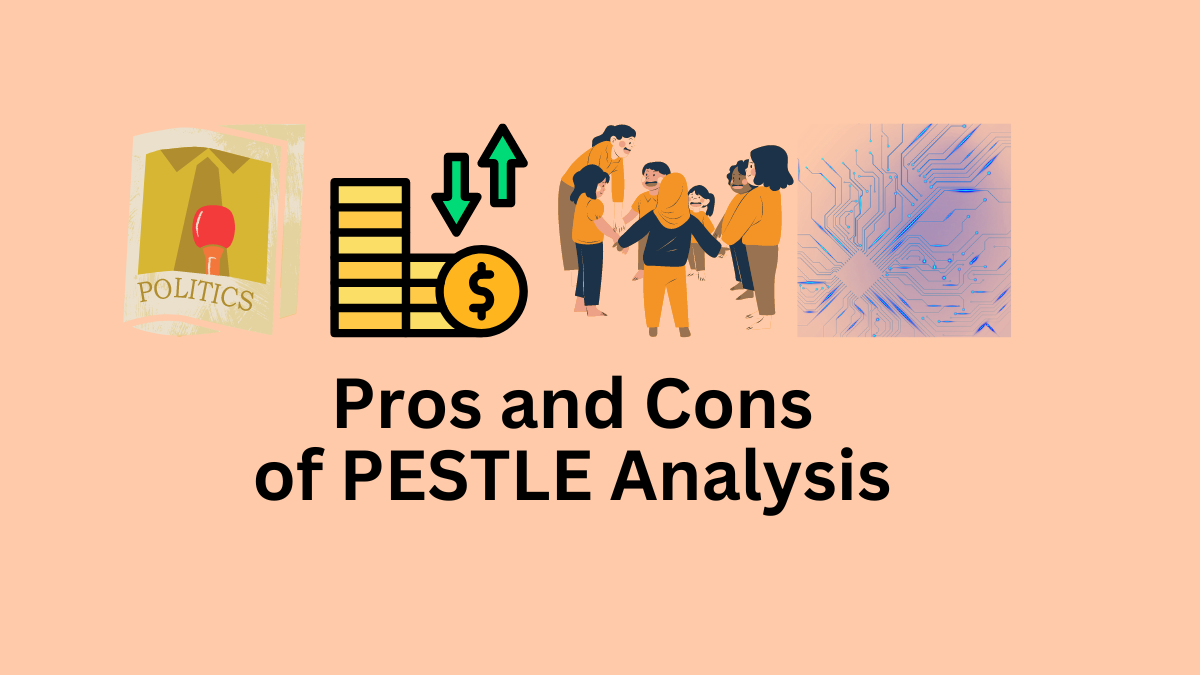Pros and Cons of PESTLE Analysis
Pestle analysis offers various benefits to businesses, and while it offers various benefits – it also has some limitations. Let’s explore the 13 essential pros and cons of PESTLE analysis.
Pros of PESTLE Analysis
Below are the 7 key benefits of PESTLE analysis to businesses.
Simplicity in Use
PESTLE analysis is user-friendly and doesn’t require complex skills. It’s like using a straightforward map to navigate your business environment. Anyone can understand and use it effectively, reducing barriers to entry for businesses of all sizes.
Future Opportunity Recognition
Think of PESTLE as a crystal ball for spotting upcoming opportunities. It’s like having advance notice of a ship approaching your shore. PESTLE helps businesses identify emerging trends and market openings so they can prepare and take advantage of them.
Threat Anticipation and Mitigation
Just as sailors prepare for storms, businesses can prepare for threats with PESTLE. By scanning the horizon for political, economic, and other factors, companies can adjust their sails (strategies) and navigate around obstacles to minimize their impact.
External Trend Awareness
PESTLE is like a trendspotter, keeping you informed about what’s “in” and “out” in the business world. It’s akin to having insider information about societal shifts that can affect your business.
Enhanced Managerial Understanding
PESTLE acts like a pair of binoculars for managers. It helps them zoom in on the bigger picture, connecting the dots between politics, economics, and other external factors. Managers become like detectives, piecing together clues to understand their environment better.
Strategic Planning Aid
Crafting a business strategy is like building a house. PESTLE is the architectural blueprint. It guides you on where to lay the foundation (economics), which walls to erect (legal factors), and how to design for the future (technological factors).
Related: Micro Environment of Marketing – Definition
Competitive Advantage Identification
Picture PESTLE as a treasure map, leading to competitive advantages. It highlights uncharted territories where businesses can excel. By knowing the terrain, companies can stake their claim before others catch on.
Cons of PESTLE Analysis
Below are the six key drawbacks of PESTLE analysis in business.
Potential Oversimplification
PESTLE analysis, while structured, might oversimplify complex business situations. It categorizes factors into specific dimensions, possibly overlooking complex connections among them. This could lead to a shallow understanding of the overall context, much like seeing a painting in black and white when it’s meant to be in color.
Limited to External Factors
Focusing solely on external factors might neglect crucial internal aspects affecting a business. Just as the engine is vital to a car’s performance, internal strengths, and weaknesses play a significant role in shaping a company’s strategy. Neglecting them could hinder effective planning, like building a car without an engine.
Rapid Change Challenges
The dynamic nature of external factors means they can swiftly shift, rendering PESTLE analysis conclusions obsolete. Quick changes in politics, technology, or regulations can catch a business off guard, making it challenging to anticipate and adapt. It’s like preparing for a sunny day only to find yourself in a sudden downpour.
Related: External Environment of Marketing – Definition
Subjectivity in Interpretation
Different individuals may interpret external factors differently based on their perspectives. This subjectivity can lead to varying conclusions and recommendations, potentially impacting the accuracy of strategic decisions. It’s like asking people about the weather and getting different forecasts.
Resource and Time-Intensive
Conducting a thorough PESTLE analysis demands substantial resources, time, and expertise. Gathering accurate and relevant data for each factor demands effort, making it a costly endeavor, especially for smaller businesses. It’s like investing a lot of time and money in collecting puzzle pieces without knowing if they will complete the picture.
Over-Reliance on Data
While data is crucial, over-reliance on data collection can lead to analysis paralysis. Organizations may become overwhelmed by data, delaying strategic decisions and hindering agility in response to market changes. It’s like having a library full of books but struggling to find the right one.
Read Next: Internal Environment of Marketing – Definition
Arti Kushmi holds a BBS (Bachelor in Business Studies) degree and shares her business and marketing knowledge through this website. While not writing she will be reading and enjoying the moment.
